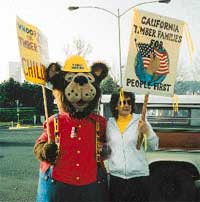Deep in the Woods
 Of california's land area of 40.4 million hectares (ha), about 40 per cent (16 million ha) is classified as forest. The us Forest Service (fs) has classified about 42 per cent of these as timberlands (timberland is forest area that can produce more than 8.1 cubic feet per ha of industrial wood annually) and eight per cent as timberlands reserved for parks and wild areas. The remaining 50 per cent can be used for watershed protection, grazing, limited wood harvest, recreation or wildlife habitat. The federal government owns and manages 55 per cent of the timberlands in California. However, 72 per cent of the timberlands in the rest of the us are under private ownership.
Of california's land area of 40.4 million hectares (ha), about 40 per cent (16 million ha) is classified as forest. The us Forest Service (fs) has classified about 42 per cent of these as timberlands (timberland is forest area that can produce more than 8.1 cubic feet per ha of industrial wood annually) and eight per cent as timberlands reserved for parks and wild areas. The remaining 50 per cent can be used for watershed protection, grazing, limited wood harvest, recreation or wildlife habitat. The federal government owns and manages 55 per cent of the timberlands in California. However, 72 per cent of the timberlands in the rest of the us are under private ownership.
Since the 1960s, management of public forests, especially timberlands, all over the us has been dogged by controversy with the forest products industry pitted against environmentalists. The two other major players, the fs and the us Congress, have traditionally supported the industry. In the Pacific Northwest of the us , including western Washington, Oregon and northern California, this controversy came to the fore in the late 1980s, when conservationists raised the issue of the Northern Spotted Owl (Strix occidentalis caurina ). This culminated in president Bill Clinton calling the Forest Conference in April 1993 in Portland, Oregon. The conference promised a new era of forest management with the fs seeking to reconcile the demands of the industry and the environmentalists.
After the conference, some local communities in the Pacific Northwest are trying to reach agreements to harvest timber while protecting the environment. This growing movement has come to be known as community forestry. The Quincy Library Group (qlg) in California is one such community group that is held up touted as a model for community-level development by the Clinton administration. Instead of fighting, environmentalists and the forest products industry in the Quincy area are trying to work together to find solutions.
However, little has changed at the national level. Congress is still trying to push policies to increase timber harvest from national forests, though the administration is opposing this. Even as national environmental groups, such as the Sierra Club and the National Wilderness Society, are fighting Congress and the fs to preserve the forests, they have a new enemy in these local community groups. And it is hard to say whether changes at the local level will influence national policies. A look into the history of forest management in the us will help provide a clearer picture.
Related Content
- Maharashtra government to promote eco-tourism in forested areas
- Assessing the health risks of natural CO2 seeps in Italy
- Newly Discovered Icelandic Current Could Change North Atlantic Climate Picture
- Big money for green hills
- Arctic rush driven by desire to control hydrocarbon deposits, shipping routes
- Solid biomass as cooking fuel is a killer
